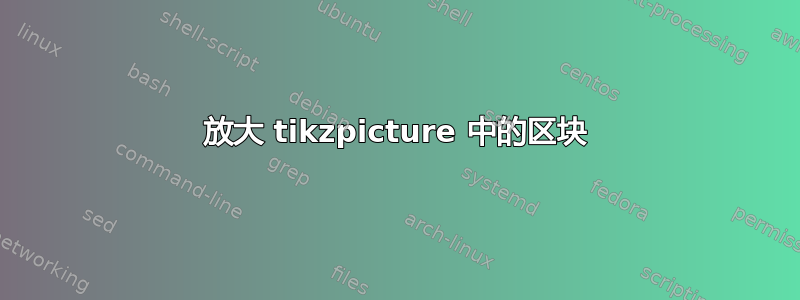
我想放大 tikzpicture 的块。此外,我想尊重页面的边距。
\documentclass[preprint,12pt]{elsarticle}
\usepackage{amssymb}
\usepackage{amsmath}
\usepackage{algorithmic}
\usepackage{algorithm}
\usepackage{subfigure}
\usepackage{tikz}
\usetikzlibrary{shapes,arrows}
\tikzstyle{decision} = [diamond, draw, fill=blue!20, text width=4.5em, text badly centered, node distance=3cm, inner sep=0pt]
\tikzstyle{block} = [rectangle, draw, fill=blue!20, text width=5em, text centered, rounded corners, minimum height=4em]
\tikzstyle{line} = [draw, -latex]
\newcommand{\bs}{\boldsymbol}
\begin{document}
\begin{tikzpicture}[auto,
block_center/.style ={rectangle, draw=black, thick, fill=white,
text width=30em, text centered,
minimum height=3em, inner sep=2pt},
block_left/.style ={rectangle, draw=black, thick, fill=white,
text width=16em, text ragged, minimum height=4em, inner sep=6pt},
block_noborder/.style ={rectangle, draw=none, thick, fill=none,
text width=18em, text centered, minimum height=1em},
block_assign/.style ={rectangle, draw=black, thick, fill=white,
text width=18em, text ragged, minimum height=3em, inner sep=6pt},
block_lost/.style ={rectangle, draw=black, thick, fill=white,
text width=16em, text ragged, minimum height=3em, inner sep=6pt},
line/.style ={draw, thick, -latex', shorten >=0pt}]
% outlining the flowchart using the PGF/TikZ matrix funtion
\matrix [column sep=5mm,row sep=3mm] {
% enrollment - row 1
\node [block_center] (referred) {(\textbf{1. Input Data} )\\
%\large
\scriptsize
%\tiny
\begin{itemize}
\item Fixed a data configuration with three regressors ($v=3$), generate a sample of size 100 for each $X^c_v$, $X^r_v$, $\varepsilon^c$, and $\varepsilon^r$ $v=1,2,3$;
%
\item Compute the response as: $y^c=\beta_0+\beta_1^c x^c_1+\beta_2^c x^c_2+\beta_3^c x^c_3$+ $\varepsilon^c$ and $y^r=\beta_0+\beta_1^r x^r_1+\beta_2^r x^c_2+\beta_3^r x^c_3+ \varepsilon^r$ with $(\beta^c_0, \beta^c_1, \beta^c_2, \beta^c_3)^T = (0, 2, -2, 5)^T$ and $(\beta^r_0, \beta^r_1, \beta^r_2, \beta^r_3)^T = (0, 1, 2, 3)^T$;
\end{itemize}
%
% CENTER AND RANGE MODEL
%
\begin{itemize}
\item Center and Range Model
\begin{itemize}
\item Fixed $L$, compute the vertices of each regular polygon $P_{jl}=(a_{jl},b_{jl}) \in \mathbb{R}^2$ with $j=1,\ldots,m$ $l=1,\ldots,L$ using the Equation (\ref{eq:aggregation}) being $c_j=x^c$ and $r_j=x^r$ for regressors and $c_j=y^c$ and $r_j=y^r$ for response.
\item Obtain the intervals for regressors $[a_j^v,b^v_j]$ with $a_{j}^v = min \{a_{j1}^v,\ldots,a_{jL}^v\}$ and $b_{j}^v = max \{b_{j1}^v,\ldots,b_{jL}^v\}$ for $j=1\ldots,m$, $v=1,2,3$. Obtain the intervals for response $[\lambda,\gamma]$ with $\lambda_{j} = min \{a_{j1},\ldots,a_{jL}\}$ and $\gamma_{j} = max \{b_{j1},\ldots,b_{jL}\}$ for $j=1\ldots,m$
%
\item By interval $(a_j, b_j)$ construct the center $c_j = (b_j + a_j)/2$ and range $r_j = (b_j - a_j)/2$.
\end{itemize}
%
% POLYGONAL REGRESSION MODEL
%
\item Polygonal Regression Model
\begin{itemize}
\item Fixed $L$, compute the vertices of each regular polygon $P_{jl}=(a_{jl},b_{jl}) \in \mathbb{R}^2$ with $j=1,\ldots,m$ $l=1,\ldots,L$ using the Equation~\ref{eq:aggregation} being $c_j=x^c$ and $r_j=x^r$ for regressors and $c_j=y^c$ and $r_j=y^r$ for response.
\end{itemize}
\item To split the data set to do 10-fod cross validation.
\end{itemize}
};&\\
\node [block_center] (assessment0) {(\textbf{2. Estimating Regression Models})
%\large
\scriptsize
%\tiny
\begin{itemize}
\item Center and Range Model
\begin{itemize}
\item Construct the CRLR model;
\item Compute the $\bs{\hat{y^c}}$ and $\bs{\hat{y^r}}$;
\item Construct the predicted squared based on the $\bs{\hat{y^c}}$ and $\bs{\hat{y^r}}$ estimates.
\end{itemize}
\item Polygonal Regression Model
\begin{itemize}
\item Construct the PLR model based on the Equation~\ref{eq:regression_model};
\item Compute the $\bs{\hat{y^c}}$ and $\bs{\hat{y^r}}$ given by Algorith~\ref{alg:algorith};
\item Construct the $\hat{P}$ by PLR model based on the Equation~\ref{eq:aggregation};
\item Calculate the area for real polygon $P_j$ and predicted polygon $\hat{P}_j$.
\end{itemize}
\end{itemize}
};&\\
% enrollment - row 4
\node [block_center] (assessment1) {(\textbf{3. Evaluation Models})
%\large
\scriptsize
%\tiny
\begin{itemize}
\item Center and Range Model
\begin{itemize}
\item Calculate the area for real polygon $P_j$ and predicted polygon $\hat{P}_j$;
\item Compute the RMSE for area of $\hat{P}$ and predicted squared.
\end{itemize}
\item Polygonal Regression Model
\begin{itemize}
\item Calculate the area for real polygon $P_j$ and predicted polygon $\hat{P}_j$;
\item Compute the RMSE for area of $\hat{P}$ and $P$.
\end{itemize}
\end{itemize}
}; \\
};% end matrix
\begin{scope}[every path/.style=line]
\path (referred) -- (assessment0);
\path (assessment0) -- (assessment1);
\end{scope}
\end{tikzpicture}
\end{document}
答案1
基本上你尝试过的方法行不通,因为tikzpicture不能跨页。自定义tcolorbox可能更好。不过我找不到在框之间制作箭头的好方法。
\documentclass[preprint,12pt]{elsarticle}
\usepackage{amssymb}
\usepackage{amsmath}
\usepackage{tcolorbox}
\tcbuselibrary{breakable,skins}
\newtcolorbox[auto counter]{plainbox}[2][]{%
enhanced,
breakable,
size=small,
colback=white,
colframe=black,
fonttitle=\bfseries\centering\large,
titlerule=0pt,
colbacktitle=white,
coltitle=black,
title=(\thetcbcounter. #2),
#1
}
\newcommand{\bs}{\boldsymbol}
\begin{document}
\begin{plainbox}{Input data}
\begin{itemize}
\item Fixed a data configuration with three regressors ($v=3$), generate a sample of size 100 for each $X^c_v$, $X^r_v$, $\varepsilon^c$, and $\varepsilon^r$ $v=1,2,3$;
%
\item Compute the response as: $y^c=\beta_0+\beta_1^c x^c_1+\beta_2^c x^c_2+\beta_3^c x^c_3$+ $\varepsilon^c$ and $y^r=\beta_0+\beta_1^r x^r_1+\beta_2^r x^c_2+\beta_3^r x^c_3+ \varepsilon^r$ with $(\beta^c_0, \beta^c_1, \beta^c_2, \beta^c_3)^T = (0, 2, -2, 5)^T$ and $(\beta^r_0, \beta^r_1, \beta^r_2, \beta^r_3)^T = (0, 1, 2, 3)^T$;
\end{itemize}
%
% CENTER AND RANGE MODEL
%
\begin{itemize}
\item Center and Range Model
\begin{itemize}
\item Fixed $L$, compute the vertices of each regular polygon $P_{jl}=(a_{jl},b_{jl}) \in \mathbb{R}^2$ with $j=1,\ldots,m$ $l=1,\ldots,L$ using the Equation (\ref{eq:aggregation}) being $c_j=x^c$ and $r_j=x^r$ for regressors and $c_j=y^c$ and $r_j=y^r$ for response.
\item Obtain the intervals for regressors $[a_j^v,b^v_j]$ with $a_{j}^v = min \{a_{j1}^v,\ldots,a_{jL}^v\}$ and $b_{j}^v = max \{b_{j1}^v,\ldots,b_{jL}^v\}$ for $j=1\ldots,m$, $v=1,2,3$. Obtain the intervals for response $[\lambda,\gamma]$ with $\lambda_{j} = min \{a_{j1},\ldots,a_{jL}\}$ and $\gamma_{j} = max \{b_{j1},\ldots,b_{jL}\}$ for $j=1\ldots,m$
%
\item By interval $(a_j, b_j)$ construct the center $c_j = (b_j + a_j)/2$ and range $r_j = (b_j - a_j)/2$.
\end{itemize}
%
% POLYGONAL REGRESSION MODEL
%
\item Polygonal Regression Model
\begin{itemize}
\item Fixed $L$, compute the vertices of each regular polygon $P_{jl}=(a_{jl},b_{jl}) \in \mathbb{R}^2$ with $j=1,\ldots,m$ $l=1,\ldots,L$ using the Equation~\ref{eq:aggregation} being $c_j=x^c$ and $r_j=x^r$ for regressors and $c_j=y^c$ and $r_j=y^r$ for response.
\end{itemize}
\item To split the data set to do 10-fod cross validation.
\end{itemize}
\end{plainbox}
\hfill$\downarrow$\hfill{}
\begin{plainbox}{Estimating regression models}
\begin{itemize}
\item Center and Range Model
\begin{itemize}
\item Construct the CRLR model;
\item Compute the $\bs{\hat{y^c}}$ and $\bs{\hat{y^r}}$;
\item Construct the predicted squared based on the $\bs{\hat{y^c}}$ and $\bs{\hat{y^r}}$ estimates.
\end{itemize}
\item Polygonal Regression Model
\begin{itemize}
\item Construct the PLR model based on the Equation~\ref{eq:regression_model};
\item Compute the $\bs{\hat{y^c}}$ and $\bs{\hat{y^r}}$ given by Algorith~\ref{alg:algorith};
\item Construct the $\hat{P}$ by PLR model based on the Equation~\ref{eq:aggregation};
\item Calculate the area for real polygon $P_j$ and predicted polygon $\hat{P}_j$.
\end{itemize}
\end{itemize}
\end{plainbox}
\hfill$\downarrow$\hfill{}
\begin{plainbox}{Evaluation Models}
\begin{itemize}
\item Center and Range Model
\begin{itemize}
\item Calculate the area for real polygon $P_j$ and predicted polygon $\hat{P}_j$;
\item Compute the RMSE for area of $\hat{P}$ and predicted squared.
\end{itemize}
\item Polygonal Regression Model
\begin{itemize}
\item Calculate the area for real polygon $P_j$ and predicted polygon $\hat{P}_j$;
\item Compute the RMSE for area of $\hat{P}$ and $P$.
\end{itemize}
\end{itemize}
\end{plainbox}
\end{document}



